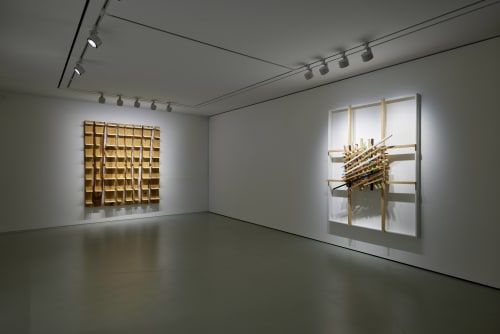조현화랑_서울을 개관하며 1970년대 일본 모노하(もの派, mono-ha) 운동을 이끈 키시오 스가의 개인전을 2024년 5월 23일부터 6월 30일까지 개최한다. 서울 신라호텔에 위치한 조현화랑_서울에서 진행되는 이번 키시오 스가 개인전은 작년 조현화랑 달맞이에서 선보였던 대규모 전시의 연장으로, 1990년대 설치 작품과 2020년 제작된 평면 오브제 작품 및 드로잉이 포함되며, 이중 두점은 이번 전시를 위해 최초로 공개되는 작품이다.
키시오스가는 1960년대 말부터 70년대 초에 일본에서 일어났던 예술운동인 모노하를 이끈 작가이다. 모노하는 물체를 단순히 재현 대상에 국한시키지 않고, 유용성과 실용성으로부터 해방시켜 물성 그 자체를 표상하는 예술운동으로, 물체 그 자체에 대한 탐구, 사물과 공간의 상호작용, 또 그것들을 마주하는 사람들과의 관계성을 중시한다. 모노하 운동 안에서도 키시오 스가는 있는 그대로의 물체(もの)들의 고유의 형태를 전달하는 것에 집중한다.자연물과 인공물을 가공하지 않고 있는 그대로 공간 안에 배치하여 연결시키는 방식으로 작업하는 그는 물체의 본질이 드러나는 상황에 주목한다. 작가로서 그가 개입하는 지점은 물체들 간 중간 영역의 조율로, 물체와 물체, 물체와 공간, 나아가 그 둘의 관계와 사람들 사이에 본질을 유지하고 각각 자유롭게 방목하여, 그 관계성을 통해 존재가 드러나도록 작품 세계를 창조한다. 키시오 스가는 본인의 작업에 대하여 “어떤 것의 한계를 창조하는 것이 아니라, 상황 그대로의 한계를 파악하고, 가장 자연스러운 존재방식이 이루어지는 상황을 취하는 것”이라고 설명한다.
이번 전시는 모노하 운동의 정신을 50년 넘게 이끌어온 작가의 최근 30년 간의 작업을 한 곳에서 만나볼 수 있도록 기획되었다. 2020년 제작된 Origin of Space는 돌, 나무, 로프를 활용하여 제작된 설치 작업이다. 검정의 네모난 나무틀 안쪽으로 로프가 V자 형태로 돌에 눌려져 있는 이 작업은 관람객으로 하여금 돌과 밧줄과 나무의 팽팽한 긴장감을 목격하게 한다. 자연에 의해 형성된 그대로의 모습을 유지한 채로 한정된 공간 속에 놓이게 된 돌은 여전히 그 자신의 개별성과 총체성을 대변하는 동시에 주변의 사물 및 관람객과의 관계 속에서 새로운 존재방식을 구축하게 되는 것이다. 나무를 겹겹이 교차 배치하여 제작한 오브제 평면 작업 Stacked Voids는 수많은 나무들의 배열이 빛과 공간 상황의 조건 하에 변화 경험을 제시한다. 여기서 관람객은 바라봄의 주체에서 벗어나, 본래의 사물이 각각 공간을 점유하고 관계함 안에서의 공존으로 초대받는다. 1993년 제작된 오브제 평면 작품인 Perceived Scenery of Extremities는 동적인 분산과 압축의 감각을 통합시킨다. 캔버스의 네모 틀을 벗어난 공간 영역을 응시함으로, 수평적 확장에 초점을 맞추는 이 작품은 사물과 공간 사이의 위계를 유연하게 넘나든다.
설치 작품을 비롯하여 평면 오브제 작업 5점과 드로잉 4점 등을 선보이는 이번 전시는 30년 간 꾸준히 이끌어온 모노하 정신 아래, 다양하고 새로운 변주들을 끊임없이 시도한 키시오 스가의 작품들을 한 자리에서 만나볼 수 있는 기회이다. 이번 조현화랑_서울 전시를 통해 관객들이 모노하 정신을 마주하고, 그의 작업들과 유동적인 관계를 형성하는 경험을 하게 될 수 있을 것이라 기대한다.
Johyun Gallery is pleased to announce the opening of its Seoul branch with a solo exhibition of Kishio Suga, a leading figure in the Japanese Mono-ha (もの派) movement of the 1970s. The exhibition will be held from May 23 to June 30, 2024, at Johyun Gallery_Seoul, located in The Shilla Seoul. This solo exhibition of Kishio Suga extends from the large-scale exhibition presented last year at Johyun Gallery_Dalmaji located in Busan, and includes installation works from the 1990s, as well as flat object works and drawings created in 2020. Among these, two pieces will be unveiled for the first time in this exhibition.
Kishio Suga is a key artist in the Mono-ha (もの派- “school of things”) movement, which emerged in Japan in the late 1960s and early 1970s. Mono-ha is an art movement that does not merely reproduce objects as subjects but liberates them from utility and practicality, representing their innate materiality. The movement emphasizes the exploration of objects, the interaction between objects and space, and the relationships with people encountering them. Within the Mono-ha movement, Kishio Suga was particularly focused on the objecthood (もの) -ness as they are. His works positioned bare and undisguised objects—natural and artificial—and focuses on situations where the essence of a thing is revealed. As an artist, his intervention lies in the coordination of the in-between spaces between objects, creating works that exist freely and organically, thereby creating a world where existence is revealed through these relationships. Kishio Suga explains his work as “not about creating boundaries, but understanding situational limits as they are, and adopting a mode of existence that is most natural.”
This exhibition brings together the past 30 years of work from an artist whose practice has led and sustained the spirit of the Mono-ha movement for over 50 years. Origin of Space (2020) is an installation work using stone, wood, and rope; on a black rectangular frame of wood, a rope is pressed into a V shape, creating a state of tension and suspension between the stone, rope, and wood. The stone in the state and form of its natural un-affected self, placed in a limit-space still represents its own individuality and entirety while a new way of existence is built on the relationships with surrounding objects and visitors. Stacked Voids (2019) is a flat object work created by cross-stacking square dowels of wood, presenting a transformative experience under the conditions of light and spatial context. Here, viewers are invited to step beyond observer-hood and into coexistence with the objects’ original occupancy and interaction within each space. Perceived Scenery of Extremities (1993) is a flat object work conjoining the antithetical senses of dynamic dispersion and compression. It draws the gaze to spaces beyond the rectangularly framed canvas and to horizontal expansion, fluidly traversing the heterogeneous phase of object and space.
Across the large installation work, five flat object works, and four drawings by Kishio Suga who has unwaveringly embodied the essence of Mono-ha across decades and variations, we look forward to exhibition visitors’ discovery of the Mono-ha spirit and engagement with the artist’s works.

